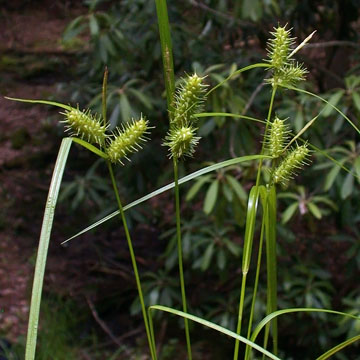

Carex baileyi - (image 1 of 4)
Taxonomy
Family: Cyperaceae
Section Vesicariae
Habitat
Swamps, wet woods, wet meadows, usually in sandy, peaty or gravelly acidic soil.
Associates
Distribution
Chiefly in the Appalachian Mountain region from Quebec and ME to NC, KY, and TN.
Morphology
Tufted perennial to 60 cm; primary leaves 10-20 cm long and 2-4 mm wide; ligule rounded, little if at all longer than wide; pistillate spikes 8-13 mm thick; perigynia 5-7 mm, the slender beak equaling or longer than the body; achene 1.5-2 mm.
Notes
Fruiting June to August
Wetland indicator: OBL
This species is similar to C. lurida but with narrower leaves and longer, more abruptly beaked perigynia. Occasional depauperate specimens of C. lurida might be mistaken for C. baileyi but normally would have the beak of the perigynium shorter than the body, leaves 4+ mm wide, and the ligule triangular and distinctly longer than wide.
The plants in these images were found growing next to a creek in peaty soil under Rhododendron maximum at a site in PA.
References
Gleason, Henry A. and A. Cronquist. 1991. Manual of Vascular Plants of
Northeastern United States and Adjacent Canada. Second Ed.
The New York Botanical Garden. Bronx, NY
|
© Michael Hough 2018 |